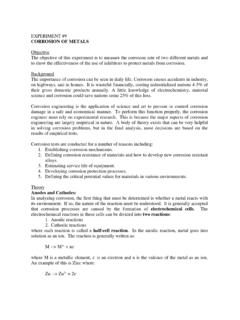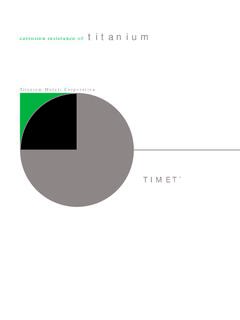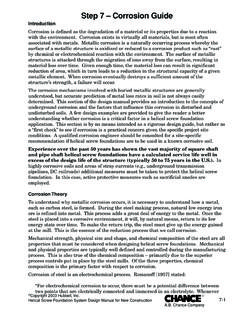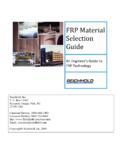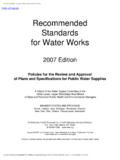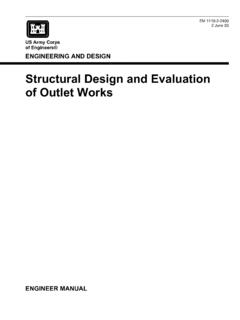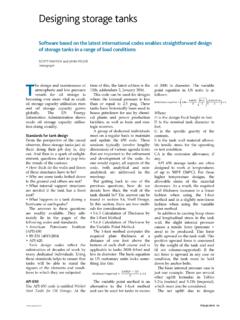Transcription of THERMOELECTRIC REFRIGERATION - Engr. Adnan Qamar
1 THERMOELECTRIC REFRIGERATION THERMOELECTRIC REFRIGERATION : An Introduction THERMOELECTRIC cooling uses the Peltier effect to create a heat flux between the junctions of two different types of materials. This effect is commonly used in camping and portable coolers and for cooling electronic components and small instruments. Applying a DC voltage difference across the THERMOELECTRIC module, an electric current will pass through the module and heat will be absorbed from one side and released at the opposite side.
2 One module face, therefore, will be cooled while the opposite face simultaneously is heated. On the other hand, maintaining a temperature difference between the two junctions of the module, a voltage difference will be generated across the module and an electrical power is delivered. BASIC PRINCIPLES OF THERMOELECTRIC MODULES Thermoelectricity is based upon following basic principles: EFFECT EFFECT EFFECT EFFECT EFFECT SeeBeck Effect: In 1821, Thomas Seebeck found that an electric current would flow continuously in a closed circuit made up of two dissimilar metals, if the junctions of the metals were maintained at two different temperatures.
3 THERMOELECTRIC power supply generators are based on the Seebeck effect which is based on voltage generation along a conductor subjected to a gradient of temperature. When a temperature gradient is applied to a conductor, an electromotive force is produced. The voltage difference generated is proportional to the temperature difference across the THERMOELECTRIC module between the two junctions, the hot and the cold one. V T SeeBeck Effect: SeeBeck Coefficient: The Seebeck coefficient is defined as the ratio of the voltage difference to the temperature gradient.
4 If the temperature difference T between the two ends of a material is small, then the Seebeck coefficient of a material is defined as: ab = V / T ab = a - b a & b is the Seebeck Coefficient with units of Volts per Kelvin for metals A & B or P & N Peltier Effect: In 1834, a French watchmaker and part time physicist, Jean Peltier found that an electrical current would produce a temperature gradient at the junction of two dissimilar metals. The Peltier effect is the main contributor to all THERMOELECTRIC cooling applications.
5 It is responsible for heat removal and heat absorbance. It states that when an electric current flows across two dissimilar conductors, the junction of the conductors will either absorb or emit heat depending on the flow of the electric current. The heat absorbed or released at the junction is proportional to the input electric current. The constant of proportionality is called the Peltier coefficient. Peltier Effect: Peltier Coefficient: When a current is made to flow through a junction between two conductors A and B, heat may be generated (or removed) at the junction.
6 The Peltier heat generated at the junction per unit time, Q , is equal to; Q I Q = abI ab = a - b where ( a & b) is the Peltier coefficient of conductor A & B, and I is the electric current (from A to B). Thompson Effect: The Thompson effect governs the cooling and the heating of a material carrying a current and subjected to a temperature gradient. It states when an electric current is passed through a conductor having a temperature gradient over its length, heat will be either absorbed by or expelled from the conductor.
7 Whether heat is absorbed or expelled depends upon the direction of both the electric current and temperature gradient. dxdTIdxdQ Joule Effect: When electrical Current I flows through a conductor of resistance R, there is dissipation of electrical energy. This is well known joule effect. The energy dissipated is given by; QJ = I2R Fourier Effect: If the ends of any element are maintained at different temperatures, the heat transfer from the hot end to the cold end is related by; The cooling and heating effects due to THERMOELECTRIC effect are given by; LkAUTTUQ chcond )(habhcabcITQITQ BASIC MECHANISM OF THERMOELECTRICS Basic Principles: A typical THERMOELECTRIC cooling component is shown on the next slide.
8 Bismuth telluride (a semiconductor), is sandwiched between two conductors, usually copper. A semiconductor (called a pellet) is used because they can be optimized for pumping heat and because the type of charge carriers within them can be chosen. The semiconductor in this examples N type (doped with electrons) therefore, the electrons move towards the positive end of the battery. The semiconductor is soldered to two conductive materials, like copper. When the voltage is applied heat is transported in the direction of current flow.
9 N-TYPE SINGLE SEMICONDUCTOR PELLET Basic Principles: When a p type semiconductor (doped with holes) is used instead, the holes move in a direction opposite the current flow. The heat is also transported in a direction opposite the current flow and in the direction of the holes. Essentially, the charge carriers dictate the direction of heat flow. P-TYPE SINGLE SEMICONDUCTOR PELLET Method of Heat Transport: Electrons can travel freely in the copper conductors but not so freely in the semiconductor. As the electrons leave the copper and enter the hot-side of the p-type, they must fill a "hole" in order to move through the p-type.
10 When the electrons fill a hole, they drop down to a lower energy level and release heat in the process. Then, as the electrons move from the p-type into the copper conductor on the cold side, the electrons are bumped back to a higher energy level and absorb heat in the process. Next, the electrons move freely through the copper until they reach the cold side of the n-type semiconductor. When the electrons move into the n-type, they must bump up an energy level in order to move through the semiconductor.
